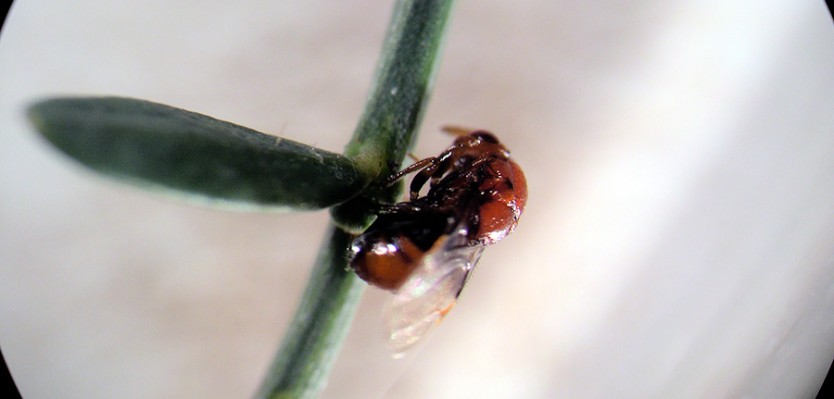
Biological control of invading plants consists in using natural enemies (e.g., the insects that cause warts in oaks, the weevils that eat seeds or larvae that eat leafs) from the regions that those plants originally come from, so that their vigour or reproductive potential may diminish. This type of control is based on the principal that, one of the factors that contributes for the plants to become invasive, is that they are introduced in a new region without any of their natural enemies.
These species are at an advantage relatively to the native species that have their enemies that feed on them, cause them sicknesses or diminish their growth in any other way. Basically, the biological control is an attempt to retrieve from the exotic species their competitive advantage, reducing their vigour to values that are similar as those of the native species.
The biological control agents do not completely exterminate the populations of their host plants. At the best, they reduce the density of the invasive species up to acceptable levels or reduce their vigour and/or reproductive potential. The fact that some plants survive assures that the agent will not disappear, meaning that the biological control process may be seen as a self-sustainable method.
Biological control for invasive plants is not yet available in Portugal. Studies have already been made for some species, but no biological control agent has yet been released into the environment. However, for the control of plant plagues (and others) several agents are available.
The application of biological control does not work in a similar way to other methodologies. The Portuguese current phase (i.e., where there are no released agents), the introduction and release of biological control agents should only be done:
-By specialists that have the necessary knowledge and experience about the biological control agents and their interaction with the plants;
-After performing specificity tests, normally in quarantine installations with a high security level, in which the organisms may be studied without the danger of escaping;
-After being subject to the security regulation imposed by the competent governmental entities;
-After having discussed the introduction project with specialists that are experienced in the subject.
These experiences determine if the candidate to agent for biological control has the ability to use other plants, besides the target plant, as a host throughout their life cycle, as well as its preferences. Only the agents proven to be sufficiently specific for hosts should be released.
Although it presents some risk, if it’s performed correctly, biological control is extremely advantageous in many aspects:
– It’s an environmentally friendly method, once it doesn’t pollute and it affects just the target invading specie;
– It is self-sustained, being a sustainable method;
– It’s cost-benefit relationship is extremely favourable, mainly when previously selected biological control agents for other sites are used.
The introduction of organisms of a region to another always implies some danger, and there are known examples of exotic biological control agents (introduced on purpose or accidentally) that have caused severe damage, namely on the native species*.
The large majority of these bad examples (at an international level) come from agents that are inserted before the second half of the XX century, taking risks that were based on arguments considered valid at that time (e.g., accepting the introduction of generalist agents).
Due to these risks, the biological control of exotic invasive species has evolved to a highly specialized science that seeks to select agents that are as specific as possible, in a way to prevent the introduction and insertion of exotic organisms that may become nefarious. However, there are possible disadvantages for this method:
– If specificity testes aren’t made in a proper manner, one may allow the introduction of an agent that can negatively affect other species;
– Some of the biological control agents operate in a relatively slow manner;
– If the introduction of an agent (after being properly authorized) is not performed carefully enough and follows inadequate procedures, there is the risk of introducing opportunistic/parasite organisms along with the biological control agent.
The long-leaved wattle (Acacia longifolia) is one of the invasive species with a more aggressive character in Portugal. In the regions of Australia from where it’s native, this specie is attacked by various species of insects, some of which are very specialized, i.e., they affect only that tree. Trichilogaster acaciaelongifoliae (vespa-australiana-formadora-de-galhas) is one of those specific enemies, which keeps the specie in equilibrium.
The insect’s first effect is the substantial reduction of the number of seeds, through the formation of antlers on the developing buds. In the long run, it leads to the reduction of the regeneration in areas that have been burnt, but in the short run it reduces the dispersion rhythm of the invasive plant. Besides this, the debilitating effects of the insect lead to a reduction of the amount of leaves that are produced, in a way that more light reaches the soil, making it available for other species of flora. On the other hand, the A. longifoliaplants are more susceptible to environmental stress, such as drought.
In Portugal, there were recently run some specificity tests, in quarantine, to evaluate the chance to use Trichilogaster acaciaelongifoliae. The good results obtained in these tests* lead to a request for its release, being currently the process in analysis by the competent authorities.
The introduction of this control agent may represent the most effective way, cheaper and with best results to environmental conservation to solve the problem of invasion by Acacia longifolia.


